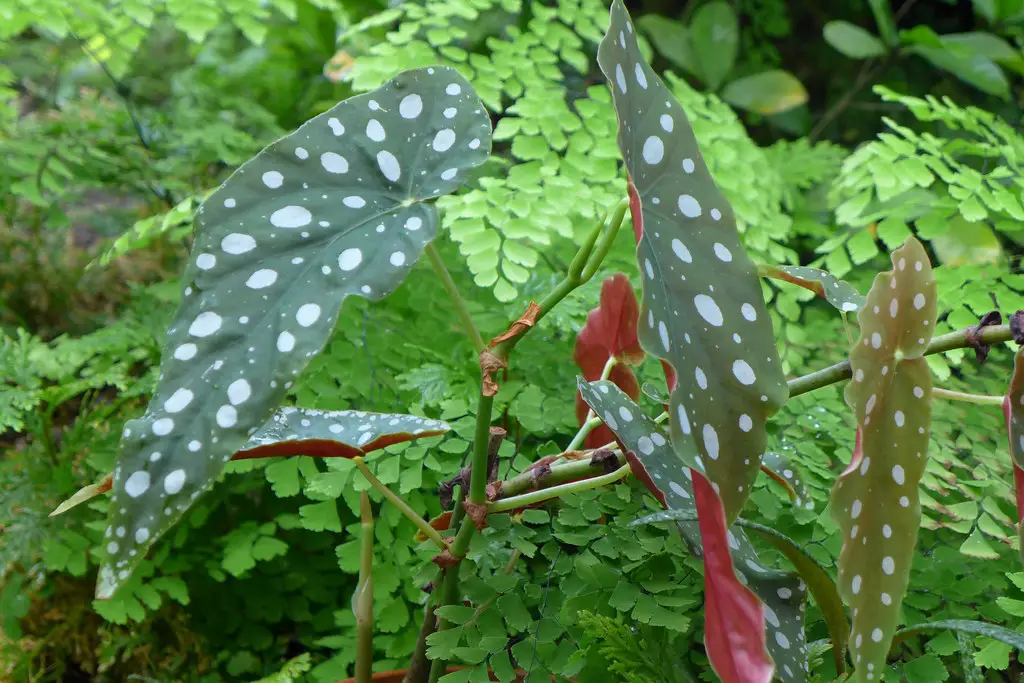Begonia Maculata, commonly known as the Polka Dot Begonia, is an attractive houseplant that’s prized for its unique appearance. It is especially known for its olive-green leaves adorned with distinctive white spots, adding charm to any indoor space.
The native habitat of Begonia Maculata spans the tropical and subtropical regions of South America. The plant belongs to the vast Begonia genus, which encompasses over 1,800 different species. The Polka Dot Begonia is highly sought after by plant enthusiasts and collectors for its aesthetic appeal.
A member of the Begoniaceae family, Begonia Maculata isn’t just a visual delight. It’s also an exciting plant to grow, as it responds well to proper care and attention, often rewarding gardeners with beautiful white or pink flowers.
| Attribute | Details |
|---|---|
| Common Names | Polka Dot Begonia, Spotted Begonia |
| Botanical Name | Begonia Maculata |
| Family | Begoniaceae |
| Plant Type | Perennial |
| Mature Size | 2-3 feet tall |
| Sun Exposure | Partial shade |
| Soil Type | Well-drained, peat-based soil |
| Hardiness Zones | 10-11 |
| Native Area | South America |
Begonia Maculata Care
Caring for Begonia Maculata requires a gentle balance of proper lighting, soil, water, and humidity. This plant prefers a consistent routine without extreme changes in its environment. When cared for correctly, the Polka Dot Begonia will not only grow but thrive, exhibiting its stunning leaves and delicate flowers.
The begonia’s leaves are sensitive to direct sunlight and excess water, so it’s essential to provide filtered light and water sparingly. This attention to detail will result in a healthy and vibrant Begonia Maculata, a show-stopping addition to any room or garden.
Light Requirement for Begonia Maculata
Begonia Maculata thrives in bright but indirect or filtered sunlight. Direct exposure to the sun can cause the leaves to scorch, while too little light may lead to leggy growth. Placing the plant near a north or east-facing window with sheer curtains is often ideal.
Soil Requirements for Begonia Maculata
A well-drained, peat-based soil mixture is suitable for Begonia Maculata. Ensure the soil is loose and allows for proper drainage to prevent root rot. A general houseplant soil with added perlite or sand can be a good option.
Water Requirements for Begonia Maculata
Watering should be done with care, as Begonia Maculata is sensitive to both overwatering and underwatering. Allow the top inch of soil to dry between watering, and reduce the frequency during winter.
Temperature and Humidity
Begonia Maculata prefers temperatures between 65-75°F (18-24°C) and higher humidity levels. Keeping the plant away from drafts and using a humidity tray or humidifier can help maintain optimal conditions.
Fertilizer
Feed Begonia Maculata with a balanced, water-soluble fertilizer every two weeks during the growing season (spring and summer). Avoid over-fertilizing, as it may cause harm to the plant.
Pruning Begonia Maculata
Pruning helps in shaping the plant and encouraging bushier growth. Remove dead or yellowing leaves and trim leggy stems to maintain its appearance.
Propagating Begonia Maculata
Propagation is commonly done through stem cuttings. Cut a stem with a few leaves, dip it in rooting hormone, and plant it in moist soil. It typically roots within a few weeks.
How To Grow Begonia Maculata From Seed
Growing Begonia Maculata from seeds is a lengthy process that requires patience. Sow seeds in well-drained soil and keep them in a warm, humid environment until germination.
Common Pests & Plant Diseases
Spider Mites
Spider mites can be a nuisance and are best treated with insecticidal soap.
Powdery Mildew
Affecting the leaves, powdery mildew can be controlled with proper airflow and humidity.
Common Problems With Begonia Maculata
Yellowing Leaves
This may be a sign of overwatering. Adjust your watering schedule and ensure proper drainage.
Drooping Leaves
Underwatering or low humidity may cause drooping leaves. Regular watering and increased humidity can solve this issue.
Pro Tips
- Avoid placing Begonia Maculata near radiators or air conditioning vents, as this can dry out the air.
- Regularly clean the leaves with a damp cloth to remove dust and allow the plant to breathe.
- Rotate the plant occasionally to ensure even growth.
- Opt for rainwater or distilled water if possible, as this plant may be sensitive to chemicals in tap water.
- Be patient with growth, especially if propagating from seed, as Begonia Maculata can be a slow grower.




